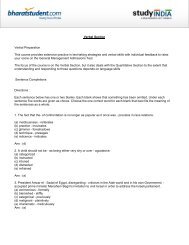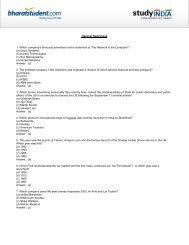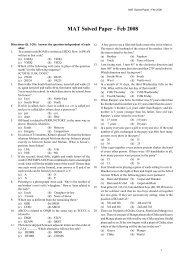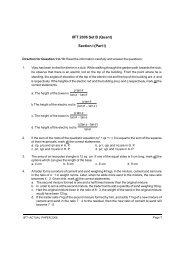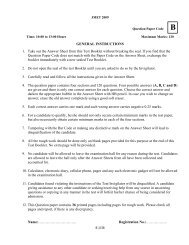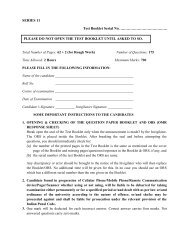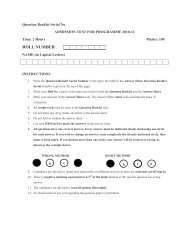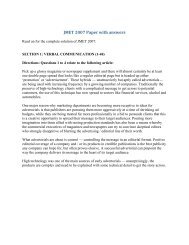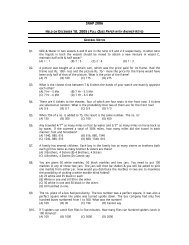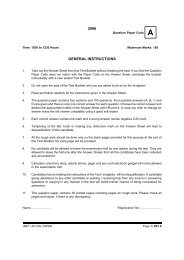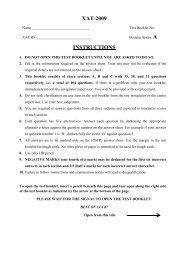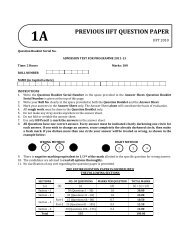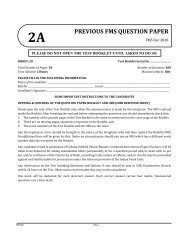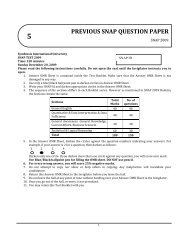ADMISSION TEST FOR PROGRAMME 2008-10
ADMISSION TEST FOR PROGRAMME 2008-10
ADMISSION TEST FOR PROGRAMME 2008-10
You also want an ePaper? Increase the reach of your titles
YUMPU automatically turns print PDFs into web optimized ePapers that Google loves.
These three insights - the metamorphosis of department stores into developed<br />
markets; customer fatigue at the existing shopping malls in India; and the need to create<br />
destination malls in Indian cities - formed the genesis of the next format we started<br />
working on, Central. The objective was to create a retail format that was much larger and<br />
totally different from what India had seen till then. It would offer everything - from<br />
multiple brands for shopping, to restaurants, coffee shops, entertainment options and<br />
gaming zones - all under one roof. If we were able to deliver on these two fronts, we<br />
could attract customers from every part of the city and make it the city's prime shopping<br />
destination.<br />
There were a couple of other issues that the Central model addressed quite well.<br />
Pantaloons outlets had limited space. We were positioning it as a fashion destination and<br />
the business model was based on selling mostly brands that we owned, or what are called<br />
private labels. However, with its increasing popularity; we were being approached by<br />
multiple foreign and Indian brands to stock these at Pantaloons. Central, being far bigger<br />
in size allowed us to open up a lot of space for other brands. However, unlike in any other<br />
mall, these brands didn't pay us rent. Instead the brands paid us a certain percentage of<br />
their sales in the mall as commission. Based on the performance of these brands, we<br />
could decide on which to keep and which to discard.<br />
The first Central mall was launched in Bangalore in May 2004. Measuring 1,20,000<br />
square feet, it was spread over six floors and housed over three hundred brands in<br />
categories like apparel, footwear, accessories, home furnishing, music and books. In<br />
addition we had coffee shops, food courts, a Food Bazaar, restaurants, pubs and<br />
discotheques. A customer could also book tickets for movies and concerts, book travel<br />
tickets and make bill payments.<br />
What has primarily made Central the ‘destination mall’ for Bangalore is its<br />
location. It is located in the heart of the city, at M.G. Road, where once Hotel Victoria<br />
stood. Moreover, we added a lot of features to further establish it as the focal point of the<br />
city. The Central Square located outside the mall building has been made available for art<br />
exhibitions, cultural performances, shows and product launches. And in 2005, the vintage<br />
car rally was flagged off from the Central flag-point, which has since become the<br />
epicenter for many such events. Thus, Central captured in all its glory what we wanted a<br />
destination mall to be, and lived up to its tagline of ‘Shop, Eat, and Celebrate.’<br />
Soon after the launch of Bangalore Central, we opened the second Central in<br />
Hyderabad in November 2004. Once again it was located at the heart of the city on the<br />
Punjagutta Cross Road. Here, the roads connecting the city centre with Secunderabad,<br />
Jubilee Hills and the old part of the city; converge. It was more than double the size of<br />
Bangalore Central. Apart from over hundreds of brands to shop, it had food courts,<br />
restaurants, as well as a five-screen multiplex managed by PVR Cinemas. Much like the<br />
one in Bangalore, Hyderabad Central didn't take much time to become the nerve centre of<br />
the city. With an annual retail turnover of around Rs 200 crore it is presently among the<br />
largest retail destinations in the country.<br />
34



